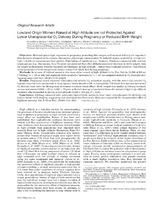Lowland origin women raised at high altitude are not protected against lower uteroplacental O2 delivery during pregnancy or reduced birth weight
Fecha
2011-04-27Autor
Julian, Colleen Glyde
Hageman, Jennifer L
Wilson, Megan J
Vargas, Enrique
Moore, Lorna G
Metadatos
Mostrar el registro completo del ítemResumen
Objective. Maternal physiologic responses to pregnancy promoting fetal oxygen and nutrient delivery are important
determinants of reproductive success. Incomplete physiologic compensation for reduced oxygen availability at high altitude ( 2,500 m) compromises fetal growth. Populations of highland (e.g., Andeans, Tibetans) compared with lowland
origin groups (e.g., Europeans, Han Chinese) are protected from this altitude-associated decrease in birth weight; here
we sought to determine whether maternal development at high altitude—rather than highland ancestry—contributed
to the protection of birth weight and uterine artery (UA) blood flow during pregnancy.
Methods. In women of lowland ancestry who were either raised at high altitude in La Paz, Bolivia (3,600–4,100 m)
(‘‘lifelong,’’ n 5 18) or who had migrated there as adults (‘‘newcomers,’’ n 5 40) we compared maternal O2 transport during pregnancy and their infant’s birth weight.
Results. Pregnancy raised maternal ventilation and arterial O2 saturation equally, with the result that arterial O2
content was similarly maintained at nonpregnant levels despite a fall in hemoglobin. UA blood flow and uteroplacental
O2 delivery were lower in lifelong than newcomer residents (main effect). Birth weight was similar in lifelong residents
versus newcomers (2,948 6 93 vs. 3,090 6 70 gm), with both having values below those of a subset of eight high-altitude residents who descended to deliver at low altitude (3,418 6 133 gm, P < 0.05).
Conclusion. Lifelong compared with newcomer high-altitude residents have lower uteroplacental O2 delivery and
similar infant birth weights, suggesting that developmental factors are likely not responsible for the protective effect of highland ancestry.

